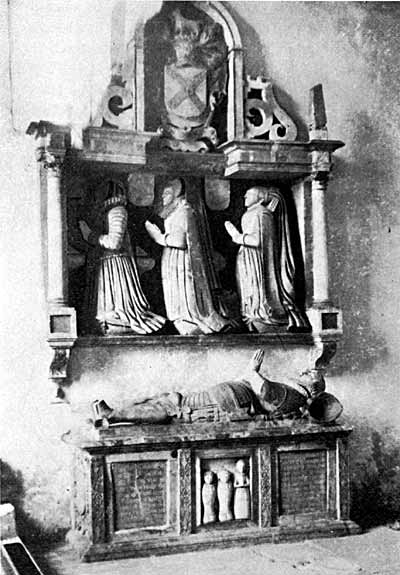MONUMENT No. 4.
Here lieth the Bodies of Henrie Sacheverell Esqier who married 3 Wives, Marie, Daughter of Robert Gittins in ye County of Kent Esqr. by who he had issue one sonn and 2 daughs. She died ye 27th of October 1600. His second wife was Elizath daughter to Willia Copleay, of Spratborowe in ye County of Yorke Esqr who died ye 13th of Maie 1616. His third wife was Lucie daughtr to Willia Boughton of Lawton in the Cou’ty of Warwick Esqr which Henrie died ye 7th of Januarie Ano Dni 1625. |

 |
| Radcliffe-on-Soar. Tomb of Henry Sacheverell (1625). |
On the south side of the chancel is the tomb of Henry Sacheverell who provided the tomb to his father and mother, and left instructions for a tomb of alabaster to be set up for himself at a cost of £40.
At one time this tomb was enclosed within iron railings; the iron wall-bracket which still remains near the east end of the wall-tomb was a support for the funeral armour and trappings. The whole monument is interesting, not only on account of the beautiful workmanship, which still retains much of the ancient colouring, but also because it well illustrates a new fashion in mural monuments then coming into vogue. The tomb is in two parts; a table or altar tomb carrying an effigy, with a reredos after the manner of a triptych behind it. Very much the same sort of thing is seen in Sir Gervase Pigot’s1 mural monument on the tower wall at Thrumpton (1669), and in the St. Andrew’s 2 tombs at Gotham (1584 and 1625).
At Radcliffe-on-Soar the Squire reclines on the table-tomb alone; above, the three ladies, kneeling in prayer represent the three successive wives of Henry Sacheverell as indicated by the unpaled shields of arms; while in the pediment a full achievement of the family arms is displayed.
ARGENT: on a saltire AZURE, five water bougets OR.
The Sacheverells originally came from San-cheverel, a town in Normandy deriving its name from a goat’s leap (de Saltu Caprioli) hence the meaning of the family crest; a wild goat passant, PROPER, attired and unguled OR; all charged with a crescent GULES for difference.
MOTTO. En bon foy. (in good faith).
On the tomb-chest is displayed the arms of Sacheverell on the west end, and on the east end the same impaling:—ARGENT a chevron SABLE charged with three buck’s heads cabossed OR for Boughton; significant of the fact that the tomb was set up after the Squire’s decease by his surviving widow. On the front of the tomb-chest in addition to the inscription in Roman lettering, the offspring by his first wife is represented, two babes who died in infancy as represented by the chrisoms, and one daughter, Eleanor, who grew up to be married to Roger Columbel of Derby.
Disappointed in not being able to leave heirs male, the third Henry willed the estate to his nephew Sir Thomas Hutchinson of Owthorpe, but he, out of tenderness to his cousin Eleanor, shared it with her. Eleanor’s share eventually passed by marriages through the Hickmans and the Marburys; and Thomas Hutchinson’s share which passed to his eldest son Colonel John Hutchinson, was eventually sold to the brother of Henry Ireton. The manor is now the property of Lord Howe.
(1) See illustrations in Thoroton’s
History, p. 16.
(2) See illustration in Thoroton’s History, pp. 21 and 22.
